|
|
- 1.
Photos
Of Complete Trolleys
- 2.
Half
Bodies In Picture Frames
- 3.
James
Edwards Personal History
- 4.
Drive
Train Notes
- 5.
Quantities,
Paint Schemes, Manufacturing & Other Misc
Ootes
- Appendix
A - Scale Discussion
SUMMARY: This
web page decribes some S-gauge PCC cars, with
hand-painted epoxy bodies, produced in small volumes by
the late James Edwards, in the 1990's
timeframe.
- Credits:
- Thanks to
traction modeler William Campbell of the
Philadelphia area for the access to the 10 cars
shown in the photos.
- Thanks to Mike
McConnell of the South Jersey S-Gaugers for taking
the following Photos 2 thru 12 on his digital
camera.
- Thanks also
to the South Jersey S-Gaugers for shutting down
their Steamtown display long enough to
photograph these PCCs on their mainline.
- Thanks to
Richard Raighn of the South Jersey S-Gaugers who
"tracked down" the surviving brother Richard
Edwards.
1.
Photos Of Complete
Trolleys
|

Photo 1 -- S-Gauge PCC Cars - Shown With American Flyer
Caboose At Left
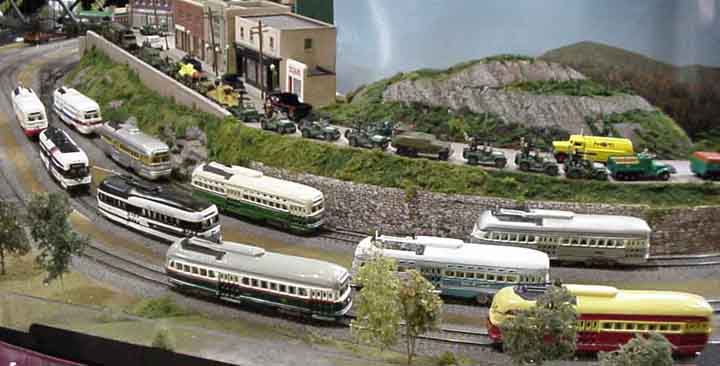
Photo 2 -- S-Gauge PCC Cars - Photographed by Mike McConnell
On The South Jersey S-Gaugers Layout At Steamtown in
Scranton PA, Memorial Day weekend
5/28/00
1a. Philadelphia Cars
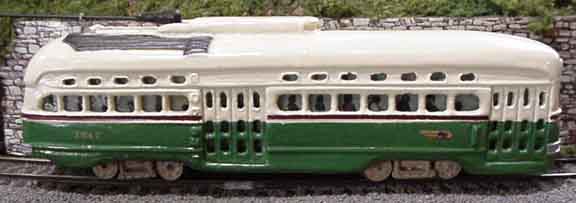
Photo 3 -- #2047 Philadelphia Transit Corp
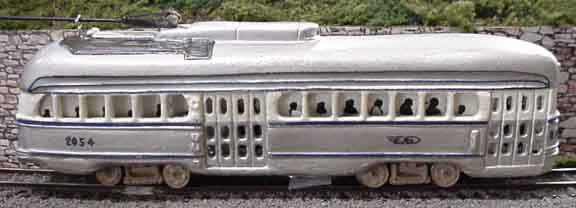
Photo 4 -- #2054 Philadelphia Transit Corp
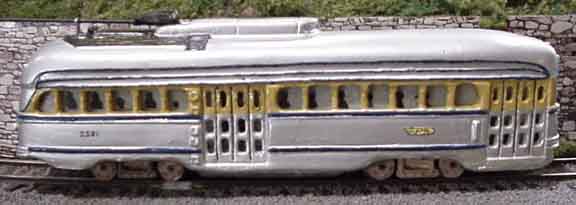
Photo 5 -- #2501 Philadelphia Transit
Corp
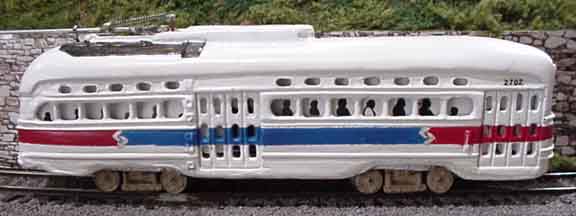
Photo 6 -- #2702 Septa
1b. Other Cars
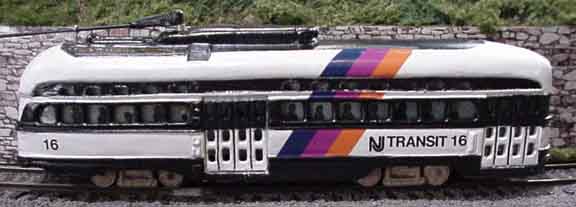
Photo 7 -- #16 New Jersey Transit
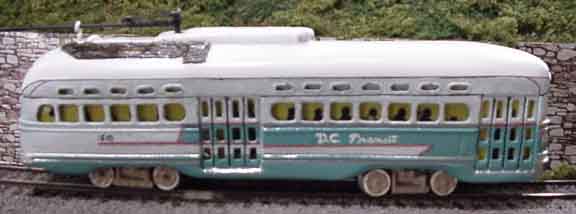
Photo 8 -- #1510 DC Trainsit
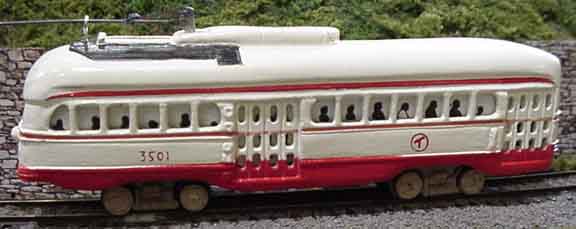
Photo 9 -- #3501 Montreal
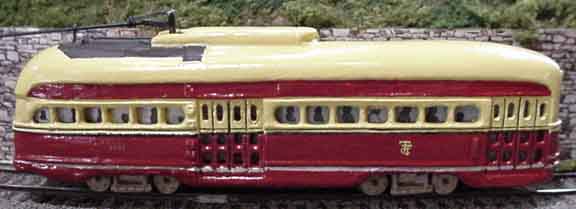
Photo 10 -- #4567 Toronto
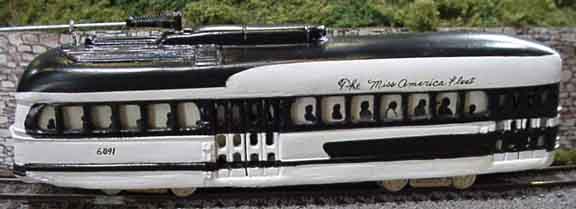
Photo 11 -- #6891 Atlantic City
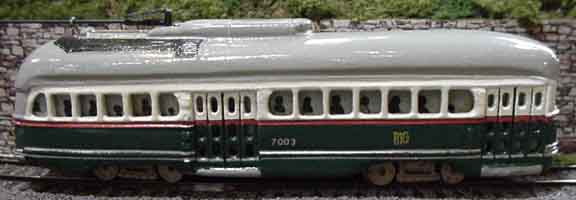
Photo 12 -- #7003 Baltimore
2.
Half Bodies In Picture
Frames
|

Photo 13 -- S Scale Bodies, Used As "Wall
Art"
- As seen in the above
Photo, James Edwards also made some 3 dimensional
"paintings".
- It appears he used the
same S-scale PCC body mold, to make half a body, that he
mounted in a picture frame. The above PCC bodies are the
same size as the full bodies shown preceding. The
building flats appears like they may really be HO
scale.
- He also made a model
of what appears to be the Kawasaki LRV body in a picture
frame, as seen in the lower left & upper right
frames.
3.
James Edwards Personal
History
|
Source Of Information
For This Artcle
- Brother Richard
Edwards--Much of this personal information came from a
conversation in June 2000 with Richard
- Nephew John Hrosovsky
- William Campbell of
Philadelphia area whose father was the largest single
purchaser of these cars.
- Wayne Schneyer of the
South Jersey S-Gaugers, a traction modeler

Figure 14 -- James Edwards Business Card
The Three Edwards
Brothers
- James Edwards, the
maker of the PCC cars, died about Dec 22 or 23, 1997, at
the ago of 59, from an aggressive cancer located between
his heart, lungs, and spine.
- Richard Edwards is the
brother who still lives at 3704 Bandon Drive, and
assisted James with production of these trolleys.
- Richard does a lot
of model painting. He currently words for IHC
(Internation Hobby Corp), on HO model railroad
projects.
- A third brother
Kenneth Edwards was never involved in the production of
the trolleys.
- The third person
listed on the business card, John Hrosovsky, was a nephew
of James Edwards. He currently lives in Philadelphia, and
is a traction fan, but not a modeler.
James Edward
Background
- James was a machinist
by trade. He was retired at the time he got involved in
the trolleys.
- He was also interested
in aircraft and fire-fighting equipment, and made models
of both these types of equipment.
- Before the trolley
project started, both James and Richard had a machine
shop, and were involved in making 3/8 scale static model
railroad display models from brass.
- At the time he got
involved in the trolley production, he was recently
divorced and his two kids had left home. Richard relates
that he dived-into the trolley project to sort of keep
himself occupied while trying to adjust to the "empty
nest" situation.
|
Editorial
Opinion: When you consider the amount of time
it must have required to make one of these cars,
including casting the body, wheel covers and truck
parts, painting and decaling everything, modifying
the Athearn power trucks, and assembling the whole
thing, James Edwards must have been producing these
cars truly as a "labor of love".
|
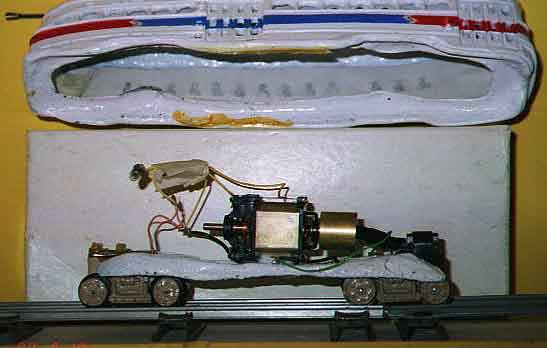
Photo 15 -- Power Chassis of Septa car.
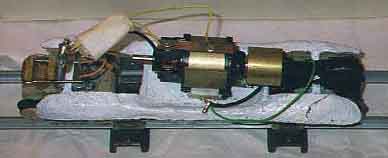
Photo 16 -- Top view of same chassis
- The preceeding two
Photos show the chassis of the Septa car. For this
particular car, the power chassis is held into the body
by a kind of rubbery cement.
- Some of the other cars
have a slightly different chassis. The chassis is
longer than the one in the above photo, and is attached
to the body by 4 screws.
Drive Train Production
Notes
- Richard Edwards
ususally made the drive trains for these
trolleys.
- Richard recalls that
they made the drive train by buying Athearn HO GP-8's and
GP-9's from Standard Hobby. They used Ace wheelsets to
change the power truck from HO to S-gauge. (As assembled,
only 4 out of the 8 wheels are picking up
power).
- Richard says luckily
the axle was the right diameter that he could push the
Athearn gear onto the Ace axle, and glue it with an ACC
bonding adhesive.
- They then took the
Athearn bodies and other leftover HO parts to Greenberg
shows, and resold what they could of the leftover HO
parts.
Drive Train
Experiments
- Richard relates that
there was a period when James was trying to eliminate the
cost of buying the Athearn drivetrain.
- He experimented with
using Radio Shack can motors, and making his own gears.
Richard reports that these drives were not very reliable,
and James went back to the Athearn
drivetrains.
- Richard relates that
James was always trying to reduce costs by doing things
himself, even though he sometimes bordered on
"reinventing the wheel".
- Richard says (tongue
in cheek) that in James way of thinking, "a shovel should
be part of of your production process, so that you could
dig up the minerals in your back yard to start with
whenever possible".
5.
Miscellaneous Other Notes
|
Some Producers Of S-Gauge
PCC Cars
There have been
at least 4 producers of S-Gauge PCC cars:
5a. Quantities & Paint Schemes
Production Quantaties --
Complete Operating S-Gauge PCC Cars
- Nephew John Hrosovsky
guesstimates that a total of about 80 of the S-gauge PCC
cars were produced, guessing in the timeframe maybe 1995
through 1997.
- John thinks there were
about 20 Toronto cars made, 7 or 8 Montreal cars, 15-20
Newark cars, plus the other paint schemes.
Paint Schemes
- Examination of the
above photos 3 through 12 on this page, reveals 4
different Philadelphia paint schemes plus 6
others.
- In addition to the 10
paint schemes shown in the above photos, John Hrosovsky
and Richard Edwards recall an MBTA Boston car, a NYC car,
a yellow Baltimore , and a "Gulf Oil" paint scheme, which
was an early Septa paint scheme similar to the Gulf
colors.
- In general, James
painted the shells. Richard recalls that Richard painted
a few of the more complex schemes, such as the New Jersey
Transit car and one of the others.
- John Hrosovsky recalls
the James had a book showing color photographs of 5000
different PCC car paint schemes, that they used as their
guide.
Production Quantaties --
S-Gauge Wall Pictures
- Nephew John Hrosovsky
guesstimates that about 40 of the S-Gauge wall pictures
were made, most with buildings (like Photo 15
above).
Selling The PCC
Cars
- Wayne Schneyer of the
South Jersey S-Gaugers remembers seeing James Edwards
selling these cars at Greenburg shows in the early 1990's
in the Philadelphia area. The selling price was about $99
per car. Wayne reports that James usually had about 6 or
8 of these PCCs with him.
- Richard says he also
advertised them in one of the S Gauge
magazines.
- Nephew John Hrosovsky
recalls making several weekend trips to Toronto, and
selling the Toronto cars to employees of Toronto
Transit.
5b. Body Manufacturing Notes
Body
Variations
From examination
of the above photos, it appears there are 4 obvious
variations in body shape:
- The bodies in Photos
3, 6, 7 & 8 have the small standee windows above the
small main windows.
- The bodies in Photos
4, 5, 9, and 12 do not have any standee
windows.
- The Toronto car in
Photo 10 has the small main windows, but no standee
windows above the main windows.
- The Atlantic City body
in Photo 11 has a "fender skirt" that covers the real
wheels.
- Also, the DC car in
Photo 8 has no ladder behind the rear doors like the
other cars (although it's difficult to see in the
photos).
Early Bodies & Later
Bodies
- Richard reports some
early trolleys were molded with 3-piece bodies. They were
about 1/4" thinner in width, had a lighted rear
headlight, and standee windows.
- The later trolleys
were 1-piece bodies. All cars shown in Photos 3 through
12 have the 1-piece bodies
- Quantity Estimates:
(for the total estimated 80 trolleys produced)
- 3-piece bodies:
about 20
- 1-piece bodies:
about 60
Other Body Production
Notes
- Richard relates that
James made silicon modes. James experimented with verious
mixtures of resins and polysterenes for the bodies.
- Richard thinks that
production of these bodies produced a lot of toxic gases,
which James refused to wear protection for, and may have
contributed to the cancer.
- Nephew John Hrosovsky
John recalls his uncle often working all night, sanding
bodies, etc.
Making The Trolley
Poles
- James made the poles
out of support mechanism from an umbrella. All he had to
do was cut out the hinge and rod from the
umbrella.
- Richard relates that
trolley-pole production would increase greatly after a
windy rainstorm, when lots of ruined umbrellas would be
available.
- The trolley pole
springs came from discarded disposable cigarette
lighter.
Oversized For
S-Gauge
- DIMENSIONS--I asked
Richard about the fact that the Edwards PCC is somewhat
oversized for S-Gauge. Richard related that James did the
first prototype on an extremely tight budget, and started
with an egg carton, and fashioned it into a PCC
body.
- See
"Appendix
A Scale Discussion"
below
for more discussion on scale.
5c. Miscellaneous Other Comments
Trolley
Layouts:
- Richard estimates
James built about 10 or 12 small trolley layouts in S
gauge, dimensions about 2 feet by 3-1/2 feet.
- James used
hand-laid, "in-street" track, to accomplish the 2 feet
diameter circle.
- Richard also built a
larger, more elaborate S-gauge layout, complete with
overhead wire, named "City Sidewalks" which they entered
into a Greenburg show.
- The nephew Richard
Hrosovsky currently has possession of this
layout.
Other S-Gauge Projects
(not completed)
- Richard relates that
the PCC cars were the only assembled, operating S-gauge
items produced.
- James made some
complete Kawasaki LRV bodies, but none of these ever got
fitted with mechanisms.
- They also made a
prototype of a GG1 body, but at about the same time
American Models introduced their GG1, and this was
abandoned.
- Richard made a
prototype of a Pacific Electric car out of wood, with the
intention that James might make a mold of that, but the
prototype languished for several years and James never
got interested.
Other Model Railroad
Projects
- James also made HO
scale PCC bodies, for mounting on a Bachman mechanism.
James supplied a kit that included the body, and also the
wheel covers to glue on the plain Bachman wheels to make
them look more like a PCC car wheel.
- James apparently also
produced some HO trolley layouts.
- James also produced a
PCC car in O gauge
- James also produced
baseball caps with railroad-themed badges on them. He did
this partly to raise funds.
Appendix
A - Scale Discussion
|
A1. Comparision Of Size
With Pope Imagineering Car

Photo 17 -- S ga. Pope Imagineering PCC Car at left, S ga.
James Edwards PCC car at Right
(Pope Car courtesy Dick Purnell, photo by Mary Jane
Purnell)
- Note from the above
photo, the Pope car at left, is almost as long, but much
lower and narrower than the James Edwards car at
right.
- Per Dick Purnell, his
Pope car as shown above, measures about 9 inches in
length [9/ (12x46.5) = 0.0161 = 1/62] which is
about 1/62 scale. The width and height are
probably much closer to 1/64 S Scale than the oversize
James Edwards car.
- Thus the James Edwards
car actually has dimensions more like a Lionel O-27 piece
of rolling stock than an actual S scale piece. If
photographed next to the Corgi PCC which is 1/50 scale,
it should be shorter than the Corgi, but have similar
width and height.
A2. Summary Of Scale Calculations
Summary
- Note: All these
measurements of the model were "eyeballed" with a ruler,
so they are not exact.
- The James Edwards
model is somewhat oversize in length, and significantly
oversize in height and width.
- The length (about
9.55 in) scales to about 1/58.4 scale (slightly
less than halfway between O and S)
- The width (about
1.95 in) calculates to about 1/52.3 scale (more
than halfway between O and S)
- The height (about
2.65 in) calculates to about 1/47.2 scale
(slightly larger than O scale)
Reference
Notes
- S Scale = 1/64
- A hypothetical scale
halfway between S & O scale would be 1/56 ((
[64+48]/2) = 1/56 ))
- O Scale = 1/48
PCC Car Dimensions Per
Philadelphia Transportation Corp. Drawing
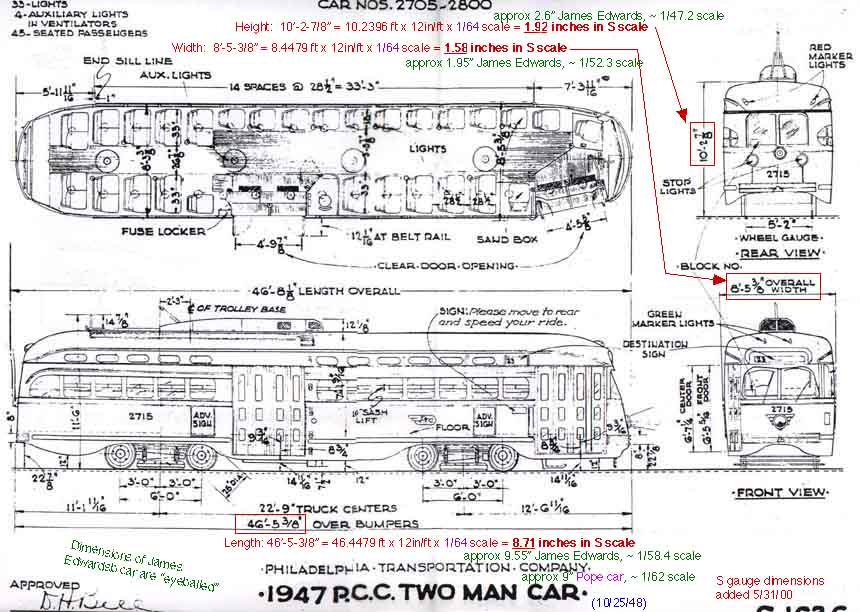
Figure 18 -- PCC Car Dimensions, from a George Metz book
(used with permission of George Metz,
5/31/00)
A3. Calculations To Determine Scale
- In real life these
cars were generally around 46-1/2 feet in length,
although they apparently varied from a low of 43 feet up
to about 50 feet in a few cases.
Length
Calculation
- These model PCC cars
eyeball at about 9.55 inches, from front bumper to rear
bumper (prototype is about 46.4479 feet long)
- Scale = Model /
Prototype =
= (9.55 in) x (1 ft/12 in) x (1/46.4479 ft ) = 0.0171 =
1 / 58.4 (ratio of model to prototype for length)
Check Of Length
Calculation
Working backwards as a
CHECK:
- As a check on this
1/58.55 calculated ratio, converting the prototype
measurements to the model measurements gives:
(46.5 ft proto ) x ( 1 model / 58.55 proto ) x ( 12
in/ft) = 9.53 "
- This 9.53"
compares with the original 9.55" we started with,
discrepancy probably due to round-off error.
Width
Calculation
- These model PCC cars
eyeball at about 1.95 inches in width (prototype is about
8.4479 feet wide)
- Scale = Model /
Prototype =
= (1.95 in) x (1 ft/12 in) x (1/8.4479 ft ) = 0.0191 =
1 / 52.3 (ratio of model to prototype for width)
Height
Calculation
- These model PCC cars
eyeball at about 2.65 inches, from top of rail to top of
body (prototype is about 10.2396 feet high)
- Scale = Model /
Prototype =
= (2.65 in) x (1 ft/12 in) x (1/10.2396 ft ) = 0.0224 =
1 / 47.2 (ratio of model to prototype for height)
This page modified 9/3/2006 (18a31) by James
R. Ingram
. . Williamsport PA
|




